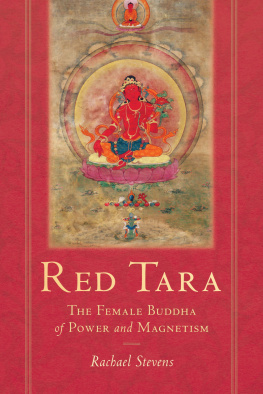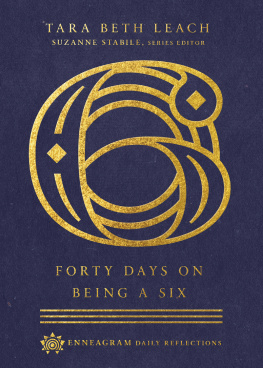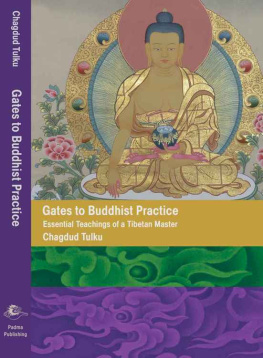

Published by
Padma Publishing
P.O. Box 279
Junction City, CA 96048-0279
www.tibetantreasures.com
Padma Publishing 1986
Second edition 1994
Reprinted 1999, 2003, 2014
eBook 2015
All rights reserved. No part of this book may be reproduced in any form or by any means, electronic or mechanical, including photocopy, recording or any information storage or retrieval system, without permission in writing from the publisher.
Printed in the United States of America
Softcover: ISBN 978-1-881847-04-5
eBook: ISBN 978-1-881847-47-2
Contents
Preface
IN THIS REVISED AND REFORMATTED edition of the Red Tara Commentary, various errors have been corrected and stylistic changes made. This edition also includes instructions for sections not in the original practice text: the mandala offering, the feast offering and the meditation for the dead.
Once again I thank all those who have helped produce this book and Chagdud Tulku Rinpoche, who has offered me the great privilege of presenting his teachings. May the powerful flow of his intention and his example inspire all who read this book and meditate on Red Tara. May all beings benefit.
Jane Tromge
[Chagdud Khadro]
Rigdzin Ling, California
Fall 1993
Preface to the First Edition
THESE WRITTEN INSTRUCTIONS for the concise Red Tara practice come from my wish that others might gain as much benefit as I have from Tara meditation. My life has been very fortunate, but still, as with all beings caught in samsaric confusion, there have been times of emotional and mental turmoil, times of illness.
In those times, by the compassion of my hearts lama, Chagdud Tulku Rinpoche, I have had a reliable method to work through obstacles, to find deep levels of comfort not dependent on outer circumstances and to penetrate, if only momentarily, the obscuring cover of my minds delusion. This method is Red Tara practice, and since having been given this wish-fulfilling gem, my life has gained rich meaning and focus.
As I wish blessing and full accomplishment of Tara practice for myself, I also wish this for all others. I hope that these instructions help and clarify your practice. I apologize in advance for any mistakes in this first edition. The instructions are meant to be used in conjunction with the short Tara practice text published by Padma Publishing. Also, they are not meant to stand on their own, but to supplement oral transmission by a qualified teacher.
Even a small project such as this book has required enormous help from many of my vajra brothers and sisters, particularly Tsering Everest, without whose insightful and intelligent translation of the teachings these instructions could not have been written.
Beyond simple gratitude, I bow in reverence before my precious teacher, Chagdud Rinpoche, whose faith in Westerners ability to comprehend the sacred Buddhadharma is unsurpassed and who displays Taras blessings as wisdom nectar, rainbow light and fireworks.
Jane Tromge
Cottage Grove, Oregon
April 1986
Introduction
The Story of Tara
COUNTLESS AEONS AGO, IN A TIME BEYOND the beginning of our time, a buddha appeared in a worldly realm called Various Lights. A princess in that realm, named Moon of Wisdom (Tib. Yeshe Dawa), developed great faith in and devotion toward the buddha. She paid homage with body, speech and mind, making immeasurable offerings to him and his retinue. When, by virtue of her vast accumulations of merit and pristine awareness, the thought of supreme enlightenment awakened in her, the monks of the realm advised her to pray for rebirth in a male body, for they thought that such a body would be a superior vehicle for enlightenment.
Because Yeshe Dawa had realized the empty nature of all phenomena, she recognized that there was no inherent reality in either the male body or the female body. Confronted by the relative reality of ignorant insistence on such differentiations, however, she made the commitment always to take rebirth in female form.
Eventually she attained a profound meditative state from which she was able to place innumerable beings in realms beyond suffering. In our own world system she manifested as Tara through the compassion of Avalokiteshvara (Tib. Chenrezi), and here she made the particular vow to liberate beings from eight great fears that are the projections of negativities within the mind. These are fear of elephants as the projection of ignorance, of fire as the projection of anger, of lions as pride, of robbers as false views, of floods as avarice, of snakes as jealousy, of handcuffs (imprisonment) as miserliness and of demons as doubt. This traditional delineation of fears encompasses all the fears and phobias that arise from our habits of attachment and aversion. Ultimately Tara offers liberation from any fear of samsaric suffering. For this reason she is called the Swift Savioress.
History of the Lineage of Red Tara
TARA IS THE FEMALE BUDDHA. Although all feminine deities are aspects of and inseparable from her, we pay particular homage to twenty-one Taras who emanate as goddesses of the padma, vajra, ratna and karma families. The methods we use to attain the enlightened qualities of Tara have been passed down through many perfect lineages of highly realized Tibetan Buddhist practitioners.
The lineage of this Red Tara meditation practiced under the guidance of Chagdud Tulku Rinpoche began in an exalted way in the intentional mind of Amitabha Buddha. From Amitabha it passed to Avalokiteshvara and then to an emanation of Tara herself. From Tara it went to the renowned Indian Buddhist master Nagarjuna and then to Padmasambhava, the great Buddhist teacher who brought vajrayana Buddhism to Tibet in the ninth century. Padmasambhava gave this teaching to the son of the Tibetan king Trisong Detzen. He also gave it to his wisdom consort, Yeshe Tsogyal, and asked that she hide it as a treasure to be discovered at a later time, when it would produce the most benefit.
Thus, the treasure of the Red Tara cycle was discovered and codified more than a thousand years after Padmasambhava, by Apong Terton, a great Nyingmapa lama who lived in this century. Its formal title is The Condensed Essence of the Treasure of Supreme Enlightened Mind: The Mandala Ritual of the Noble Red Tara Called the Wish-Fulfilling Essence.
At the end of his life, Apong Terton summoned a monk whom he had initiated into Red Tara and told him, I am dyingI ask that you do something for me. When I am seventeen years old in my next incarnation, come to me and give me the initiation and oral transmissions of the complete Red Tara treasure.
After Apong Terton died, the Chinese consolidated their conquest of Tibet, and the monk, like so many others, was forced to flee. He became a refugee in the small country of Bhutan. Apong Terton reincarnated as His Holiness Sakya Trizin, head of the Sakyapa tradition of Tibetan Buddhism. When Sakya Trizin was seventeen years old, the monk tried to go to him at a place near Dehra Dun in northern India, but he could not get a passport. It was not until several years later that he, appearing rather ragged in the richly ornamented meditation hall of Sakya Trizins monastery, was able to meet his former teacher.
A few moments after the monk spoke to Sakya Trizin, the assembly of monks in the shrine room was surprised to be dismissed and to learn that His Holiness would take initiation from the outwardly undistinguished visitor. The monk then gave the Red Tara initiation to Sakya Trizin and Sakya Trizins remarkable sister, Jetsunma.
Next page













